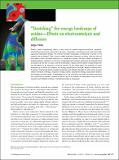“Stretching” the energy landscape of oxides—Effects on electrocatalysis and diffusion
Author(s)
Yildiz, Bilge
Downloadbilge_Stretching the.pdf (722.6Kb)
PUBLISHER_POLICY
Publisher Policy
Article is made available in accordance with the publisher's policy and may be subject to US copyright law. Please refer to the publisher's site for terms of use.
Terms of use
Metadata
Show full item recordAbstract
Elastic strain engineering offers a new route to enable high-performance catalysts, electrochemical energy conversion devices, separation membranes and memristors. By applying mechanical stress, the inherent energy landscape of reactions involved in the material can be altered. This is the so-called mechano-chemical coupling. Here we discuss how elastic strain activates reactions on metals and oxides. We also present analogies to strained polymer reactions. A rich set of investigations have been performed on strained metal surfaces over the last 15 years, and the mechanistic reasons behind strain-induced reactivity are explained by an electronic structure model. On the other hand, the potential of strain engineering of oxides for catalytic and energy applications has been largely underexplored. In oxides, mechanical stress couples to reaction and diffusion kinetics by altering the oxygen defect formation enthalpy, migration energy barrier, adsorption energy, dissociation barrier, and charge transfer barrier. A generalization of the principles for stress activated reactions from polymers to metals to oxides is offered, and the prospect of using elastic strain to tune reaction and diffusion kinetics in functional oxides is discussed.
Date issued
2014-02Department
Massachusetts Institute of Technology. Department of Nuclear Science and EngineeringJournal
MRS Bulletin
Publisher
Cambridge University Press/Materials Research Society
Citation
Yildiz, Bilge. “‘Stretching’ the Energy Landscape of oxides—Effects on Electrocatalysis and Diffusion.” MRS Bulletin 39, no. 02 (February 2014): 147–156. © 2014 Materials Research Society.
Version: Final published version
ISSN
0883-7694
1938-1425